- Преподавателю
- Иностранные языки
- Интегрированный урок МХК и английский язык Мосты повисли над водами
Интегрированный урок МХК и английский язык Мосты повисли над водами
| Раздел | Иностранные языки |
| Класс | 10 класс |
| Тип | Конспекты |
| Автор | Гоголева Т.К. |
| Дата | 22.09.2015 |
| Формат | docx |
| Изображения | Есть |
Интегрированный урок «The Bridges hanging over water»
10 класс
МХК и английский язык
Опережающее обучение
Преподаватель английского языка СПб СВУ Гоголева Т.К.
Цель урока: совершенствовать навыки изучающего чтения и активизация монологической и диалогической речи.
Задачи урока:
-
общеобразовательные:
-
расширение лексического запаса учащихся;
-
развитие навыков чтения и извлечения основной информации;
-
развитие иноязычных навыков говорения.
2. Развивающие:
-
памяти, логического мышления;
-
развитие информационной и социокультурной компетенции;
-
расширение знания учащихся об окружающем мире.
3.Воспитательные:
-
развивать у учащихся интерес к культурно-историческому наследию;
-
развивать у учащихся наблюдательность;
-
развивать интерес к урокам иностранного языка и МХК;
-
научить работать в группе.
Речевой материал:
УМК «Английский в фокусе»,
10 класс, Ю.Е. Ваулина, В. Эванс.
Материальное обеспечение урока: учебник для общеобразовательных учреждений «Английский язык» 10 класс, раздаточный материал, видеоролик, презентация по теме урока.
Метод работы:
коммуникативный метод обучения.
Ход урока:
-
Организационный момент
-
Приветствие: "Good afternoon, suvorovites! I'm glad to see you!"
Введение в тему "The distinctive features of the skyline are …."
-
Речевая зарядка
Teacher: "Why is Saint-Petersburg called Northern Venice?"
Просмотр видеоролика «Мосты Санкт-Петербурга»
Teacher: "What does this video illustrate?"
-
Генерирование идей (brainstorming) "What do the numbers refer to?"
-
Чтение c извлечением информации.
Teacher: "Read the text and elicit information about the numbers on board."
St. Petersburg was built on the delta of the River Neva and is spread out over numerous islands of varying sizes, frequently prompting the nickname the "City of 101 Islands". Peter the Great was designing the city as another Amsterdam and Venice, with canals instead of streets and citizens skillful in sailing. THE NEVA RIVER is an essential part of St. Petersburg's charm. The river flows 74 km from Lake Ladoga to the Gulf of Finland in the Baltic Sea. On average the Neva River is 400-600 meters wide. Initially, there were only about ten bridges constructed in the city. The citizens were supposed to move around in boats, and in the winter months when the water froze to move in sledges. The first permanent bridge of bricks and stones across the main branch of the Neva river appeared in 1850. Today, there are 342 bridges over canals and rivers of various sizes, styles and constructions, built at different periods. There are about 800 small bridges across hundreds of smaller ponds and lakes in public parks and gardens, and over 100 bridges in various ports, marinas, yacht clubs and private industries.
-
Работа в парах. Мини диалоги по извлеченной из текста информации.
Teacher:"In pairs, ask and answer questions based on the text. (Use the information you were looking for)"
-
Работа с текстом. Заполнение пропусков.
-
Read the text and choose the correct parts of sentences (A - H) to complete gaps 1- 7. There is one extra part of the sentence you do not need to use.
It's hard to move more than a few hundred meters in the centre of St. Petersburg without crossing a bridge. The network of rivers and canals that comprises the Neva Delta has made bridges and bridge-building a vital part of St. Petersburg's infrastructure since the foundation of the city, and many of Russia's prominent architects and engineers 1)___________. There are 342 bridges in the city. Many of these structures are masterpieces of engineering and architecture .
There are bridges over canals and rivers of various sizes, styles and constructions, built at different periods. Some of them are small pedestrian bridges, such as Bank and Lion bridges, others are huge transport arteries such as almost one kilometer long Alexander Nevsky Bridge. The total number of bridges in Saint Petersburg is over a thousand. The nearly 100-meter-wide Blue Bridge, 2)___________, spans the Moyka River. There are bridges 3)____________ with such decorations as statues, lamplights, lions, horses, sphinxes and griffins, and there are modern styles lacking any decor.
The names of the bridges 4)____________ as well. Some take their names from geographic locations - such as English, Italian and Egyptian bridges. Other names refer to the places such as Postoffice, Theatre and Bank bridges. Many bridges are named after famous people - Alexander Nevsky, Peter the Great, Lomonosov bridges. There are "coloured" bridges - Red, Green, Blue and Yellow bridges.
A familiar view of Saint Petersburg is a drawbridge across the Neva. Every night during the navigation period from April to November, 22 bridges across Neva and main canals 5)___________ of the Baltic Sea into the Volga-Baltic waterway system. A calculated schedule with precise time of consecutive opening and closing for each bridge is maintained to 6)__________ at a precisely controlled speed, in order to have at least one bridge at a time staying connected to ensure passage for firefighters, police, ambulances and other ground transportation. It was not until 2004 that the first high bridge across the Neva, which does not need to be drawn, Big Obukhovsky Bridge, was opened. There are hundreds of smaller bridges in Saint Petersburg 7)______________, some of the most important of which are the Moika, Fontanka, Griboyedov Canal, Obvodny Canal, Karpovka and Smolenka.
-
claimed to be the widest in the world
-
have taken up the challenge over the last three centuries
-
spanning across numerous canals and distributaries of the Neva
-
are drawn to let ships pass in and out
-
guarantee passage of cargo ships and tankers
-
are of a great diversity
-
designed in various styles
-
its reputation as the most beautiful city in the country
-
Работа с лексикой текста.
Teacher: "Match the words in italics in the text to these meanings."
preserved thoroughly accurate without well-known essential outstanding includes
-
Монологическое высказывание по прочитанному тексту.
Speaking. Teacher: "Tell you partner three things you remember from the text."
-
Работа в группах. Учащиеся делятся на группы по 5-6 человек. Каждый читает свой текст. Затем группа отвечает письменно на вопросы.
Teacher: "Make a group of 5-6, Each student has to read one text. Then in a group complete a questionnaire."
Anichkov Bridge
Anichkov Bridge is one of the architectural highlights of Nevsky Prospect, and essential viewing for any visitor to St. Petersburg, both for the spectacular views of the surrounding palaces from the vantage point of its humped back, and for the famous sculptures - the Horse Tamers - that crown its four corners.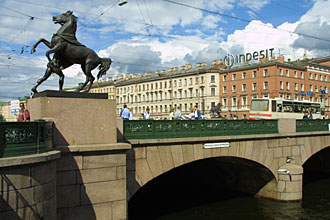
Carrying Nevsky Prospekt across the Fontanka River, the first Anichkov Bridge was a wooden structure erected as early as 1716. Its name honours the engineer of that first bridge, Mikhail Anichkov. In the 1780s, a series of almost identical stone bascule bridges were built across the Fontanka, and Anichkov Bridge was one of them.
By the 1840s, however, Anichkov Bridge, with its four towers housing the raising mechanism, was unable to cope with the ever-increasing volumes of traffic along Nevsky Prospekt, and the decision was taken broaden the bridge, making it a similar width to the avenue itself. The result was the modern bridge, although it had to be fundamentally reconstructed in 1906-1908 due to structural flaws in the arches.
A simple but elegant structure, Anichkov Bridge consists of three arched spans faced with pink granite, and measures 54.6 meters. To decorate the bridge, cast-iron railings were installed to a design by Karl Friedrich Schinkel for Berlin's Palace Bridge. They have ornate symmetrical designs featuring mermaids and fantastical seahorses.
The most striking decorations on Anichkov Bridge, however, are the Horse Tamers by Pyotr Klodt. These beautiful bronze cast proved so popular that copies of the sets at the eastern end of the bridge, installed in 1841, were sent as Imperial gifts to Frederick William IV of Prussia and to the City of Naples within a decade. The sculptures at the western end were erected in 1850. During the Siege of Leningrad, the sculptures were removed and buried in the grounds of the Anichkov Palace nearby. Thus, unlike the bridge, they survived the war intact. All damage was repaired, however, and the statues were restored to their rightful place on 1 May 1945, a week before victory was declared.
Anichkov Bridge is a popular attraction thanks to its central location.
Lomonosov Bridge
Named after the great Russian polymath Mikhail Lomonosov, whose advances in chemistry, mathematics, linguistics and literature made him a kind of one-man Russian Enlightenment during the reigns of tsarinas Elizabeth and Catherine the Great, this beautiful stone bridge crosses the Fontanka River about 300m south of Nevsky Prospekt. Dating from the late 18th century, and with its original design still intact, Lomonosov Bridge is well worth a short detour.
Originally called Chernyshev Bridge in honour of Count Grigory Chernyshev, one of Peter the Great's most prominent generals, whose estates were located nearby, the bridge was erected in 1785-87 and replaced a wooden bridge which had previously stood at the site. It was one of seven stone moveable bridges of similar design crossing the Fontanka River, built simultaneously with the river's granite embankments. Only Lomonosov Bridge and Staro-Kalinkin Bridge have survived more or less intact.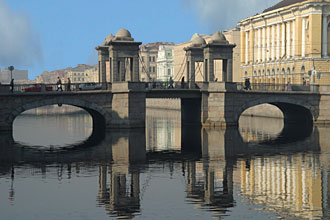
Measuring 57.1 meters, the bridge consists of two broad, arched side-spans, and a shorter central span that was originally of wood, but replaced with steel in 1913. Although Lomonosov Bridge no longer rises to allow passing traffic, it has retained its four charming Doric pavilions, which once housed the drawbridge mechanism. It is these that give the bridge its distinctive outline and particular charm.
In 1915, granite obelisks with elegant cast-iron streetlamps were added to the bridge, and in 1948, the bridge was given its current name.
The Bank Bridge
Just a few minutes' walk down the Griboedov Canal from Nevsky Prospect and Kazan Cathedral, St. Petersburg's Bank Bridge is one of the world's most beautiful pedestrian bridges, thanks to the glorious sculptures of golden-winged griffons by famous local sculptor Pavel Sokolov. At 1.85 meters, it is also the narrowest in the city, a miniature architectural gem.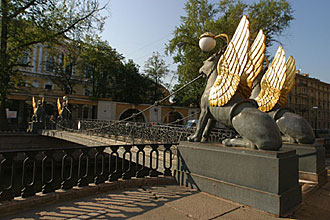
The bridge takes its name from the Assignation Bank, one of Russia's first public banks, which was housed in the beautiful neoclassical mansion next to the bridge, now home, appropriately, to the St. Petersburg State University of Economics and Finance. Like many of the bridges across the Griboedov Canal, Bank Bridge was built in 1825-26 to a design by German-born engineer Wilhelm Von Traitteur. The Bank Bridge is a small pedestrian suspension bridge, whose innovative design hides the bridge's supports inside elegant sculptures.
The deck of Bank Bridge is wooden, keeping the structure relatively light, and it has been replaced several times in nearly two centuries. As well as the griffons, Bank Bridge features beautiful cast-iron railings, notable for their ornate, palm-frond design. The original railings were removed at the beginning of the 20th century, and the current railings were installed in 1952, recreated from the original designs.
The griffons, which are unquestionably the main attraction of the bridge, are one example of numerous monumental sculptures in St. Petersburg by Pavel Sokolov. Sokolov was a graduate of the Imperial Academy of Art, who was most famous for his sculpture Milkmaid with Broken Jar in the Catherine Park at Tsarskoe Selo until, in 1825, he was commissioned to design not only the griffons for Bank Bridge, but also the lion statues for the Lions Bridge, and the sphinxes for the Egyptian Bridge. All of these sculptural ensembles have become emblems of St. Petersburg, and the griffons, with their strict classical form marked by golden wings and beautiful curved golden lamp brackets, may be the finest of them.
Trinity Bridge
The Trinity (Troitsky) Bridge was opened in 1903 as part of the celebrations of St. Petersburg's 200th anniversary. It was the third permanent bridge, after Lieutenant Schmidt Bridge and Liteiniy Bridge, to be laid across the River Neva, running from north of the Field of Mars on the left bank of the river to the Petrograd Side next to the Peter and Paul Fortress. Measuring 582 meters, it is the second longest bridge in the city, one of the busiest, and also one of the most beautiful thanks to its spectacularly ornate Art Nouveau design.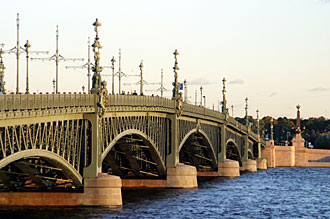
There was a clear need for a permanent bridge in this area from the early 19th century, but it was not until 1892 that a tender was announced for designs. The competition attracted international attention, and the initial winner was the company of Gustave Eiffel, the engineer of Paris's most famous landmark, who had won his early fame designing state-of-the-art railway bridges. Although Eiffel was awarded the princely prize of 6,000 roubles, his design was subsequently ignored in favour of another French company, the Batignolles Building Company.
It was another five years before construction began, with the first stone laid on 12 August 1897. The l building process was accompanied by rumours of financial scandal, but the bridge was nonetheless completed on time, and Nicholas II was present to witness the first official raising of the bridge in the late spring of 1903.
The new bridge was worth waiting. It has a total of nine spans - three stone spans closest to the right bank, five fixed steel spans and one bascule steel span. The original opening system featured two symmetrical wings, but was replaced in 1967 by a single 43-metre rising wing. The bridge's elegant, low outline is complemented by a wealth of decoration, including beautiful tripod streetlamps, curving cast-iron railings and granite obelisks topped with two-headed Imperial eagles.
The bridge's name refers to the Trinity Cathedral, which once stood by the river on the Petrograd Side. The name was changed to Bridge of Equality in 1918, and the Cathedral was destroyed soon after. In 1934, the bridge was renamed to honour Sergei Kirov, revolutionary and Bolshevik leader of Petrograd. The original name was restored in 1999.
Blagoveshchensky (Annunciation) Bridge
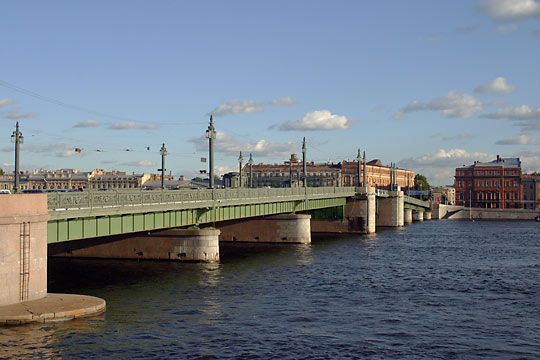
The Blagoveshchensky (Annunciation) Bridge (from 1855 to 1918 Nikolaevsky Bridge; from 1918 to 2007 called Lieutenant Schmidt Bridge) is the first permanent bridge built across the Neva River in Saint Petersburg. It connects Vasilievsky Island and the central part of the city. The bridge's length is 331 meters and the width was 24 meters. Completed in 1850 it was the longest in Europe at that time.. The original name of the bridge was Nevsky Bridge. It was later renamed Blagoveshchensky Bridge. After the death of Tsar Nicholas I, it was named Nikolaevsky Bridge in his honour, and in 1918 it received the name Lieutenant Schmidt Bridge.
The bridge was built in 1843-1850. It was designed by Stanisław Kierbedź, a Polish engineer working in Russia. The architect Alexander Brullov participated in the decoration. The design was a cast iron bridge with a bascule section. At the time, it was the longest bridge in Europe. According to the legend, the Russian Tsar, Nicholas I promised to Kierbedź to give him a promotion for every completed span. After the bridge was completed with eight spans total in it, Kierbedź was promoted to the rank of a General, but actually when he started the construction he already had a rank of Podpolkovnik (i.e. lieutenant colonel). The beautiful eight-span arch bridge is famous for its ornate cast-iron railings.
Liteiny Bridge
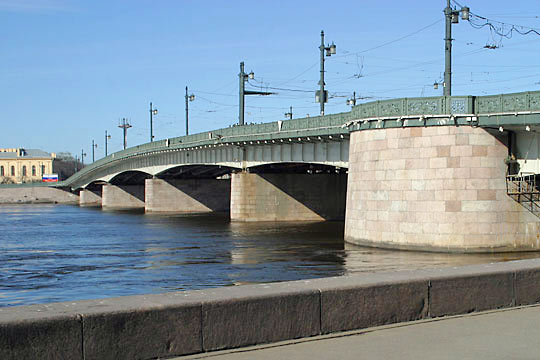
Joining Liteiny Prospekt with the Vyborg Side, Liteiny Bridge is a 396-meter, six-arch bascule bridge, crossing the Neva River at its deepest point. Built between 1874 and 1879 to a design by military engineers Struve and Veis, the bridge was officially named after Alexander II, but quickly became known as Liteiny. The arch nearest to the left bank rises 67° to allow ships to pass. The elegant cast-iron railings of the bridge are of high esthetic value. The railings were moulded after the design of K.K. Rahau. The pattern depicts mermaids holding the emblem of Saint-Petersburg (two crossed anchors). There are 546 such patterns on the bridge.
In 1879 the bridge was equipped with electrical lights - the invention of Russian inventor Pavel Yablochkov. It was the first bridge to get electrical lighting and for the long time it remained the only one, since the monopoly of gas producers in city opposed it.
In 1967, the bridge was reconstructed to accommodate taller ships and six lanes of traffic.
Questionnaire
-
Where can you see mermaids on the railings?
-
Which bridge/bridges has a single rising wing?
-
What was the first permanent bridge across the Neva
-
How did the architect get the highest rank while building a bridge?
-
Where can pedestrians move only?
-
Which bridge honours its creator?
-
What bridge/bridges has/have elegant sculptures?
-
Which bridge/bridges is/are one from the whole series?
-
Which bridges/bridge no longer rise?
-
What railings were installed to a design for a palace?
-
What is the second longest bridge in the city?
-
Which bridge crosses Neva at its deepest point?
-
Which bridge/bridges was/were originally made from wood?
-
What decorations were buried in the grounds?
-
Where was electrical lightning introduced first?
-
Which bridge was the longest in Europe at the time of its construction?
-
The name of what bridge/bridges was once linked with its location?
-
What is the narrowest bridge in the city?
-
Which bridge was opened as a tribute to the city's anniversary?
-
The decoration of which bridge/bridges includes beautiful streetlamps?
-
Подведение итогов урока. Рефлексия.
Teacher: "Can you recognize the bridge on the picture?"
-
Задание для самостоятельной подготовки:
Write the composition " The city of bridges"


